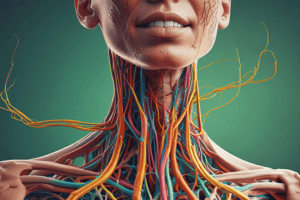Podcast
Questions and Answers
Which of the following structures is part of the lymphatic system?
Which of the following structures is part of the lymphatic system?
- Alveolar sac
- Trachea
- Cricoid cartilage
- Cervical lymph nodes (correct)
What is the primary function of the pharynx?
What is the primary function of the pharynx?
- To carry out gas exchange
- To carry air and food (correct)
- To produce sound
- To trap pathogens
Which component is located after the primary bronchi in the bronchial tree?
Which component is located after the primary bronchi in the bronchial tree?
- Carina
- Terminal bronchiole
- Secondary bronchi (correct)
- Trachealis
The thoracic duct is responsible for draining lymph from which areas of the body?
The thoracic duct is responsible for draining lymph from which areas of the body?
Which of the following structures is NOT part of the respiratory system?
Which of the following structures is NOT part of the respiratory system?
Which structure is responsible for preventing food from entering the trachea during swallowing?
Which structure is responsible for preventing food from entering the trachea during swallowing?
Which of the following best describes the function of alveoli?
Which of the following best describes the function of alveoli?
What role do lymphatic trunks play in the lymphatic system?
What role do lymphatic trunks play in the lymphatic system?
Flashcards are hidden until you start studying
Study Notes
Lymphatic Structures
- Lymph Nodes: Small, bean-shaped organs that filter lymph fluid, containing immune cells to fight infections.
- Cervical: Located in the neck.
- Axillary: Located in the armpit.
- Thoracic: Located in the chest.
- Abdominopelvic: Located in the abdomen and pelvis.
- Intestinal: Located in the small intestine.
- Inguinal: Located in the groin.
- Popliteal: Located behind the knee.
- Jugular Trunks: Collect lymph from the head and neck.
- Subclavian Trunks: Collect lymph from the upper limbs and chest.
- Bronchomediastinal Trunks: Collect lymph from the chest and lungs.
- Intercostal Trunks: Collect lymph from the chest wall.
- Lumbar Trunks: Collect lymph from the lower limbs and abdomen.
- Intestinal Trunks: Collect lymph from the intestines.
- Cisterna Chyli: A large, sac-like structure that collects lymph from the lower body.
- Right Lymphatic Duct: Drains lymph from the right side of the body, including the right arm, right side of the head and neck, and right side of the chest.
- Thoracic Duct: Drains lymph from the rest of the body.
Respiratory Structures
- Nose: The entry point for air.
- External nares: Nostrils, the openings of the nasal cavity.
- Nasal vestibule: The entryway to the nasal cavity.
- Nasal cavity: The space within the nose, lined with mucous membrane to filter and warm the air.
- Palatine tonsils: Lymphoid tissue located in the back of the throat; protects against pathogens.
- Lingual tonsils: Lymphoid tissue located at the base of the tongue; protects against pathogens.
- Pharyngeal tonsil (adenoid): Lymphoid tissue located in the nasopharynx; protects against pathogens.
- Pharynx: A muscular tube that carries both air and food.
- Nasopharynx: The uppermost part of the pharynx, behind the nasal cavity.
- Oropharynx: The middle part of the pharynx, behind the mouth.
- Laryngopharynx: The lowermost part of the pharynx, connected to the larynx.
- Larynx: A cartilaginous structure located in the neck, responsible for voice production.
- Epiglottis: A flap of cartilage that closes off the airway during swallowing, preventing food from entering the trachea.
- Glottis: The opening between the vocal cords.
- Thyroid cartilage: The "Adam's apple," a large cartilage that shields the larynx.
- Cricoid cartilage: A ring-shaped cartilage that supports the trachea.
- Vocal cords: Elastic tissues that vibrate to produce sound.
- Vestibular folds: False vocal cords, which help in vocalization but do not vibrate.
- Trachea: A tube that carries air to the lungs.
- Cartilaginous rings: C-shaped rings that provide structural support to the trachea.
- Carina: A ridge that divides the trachea into the right and left bronchi.
- Trachealis: A smooth muscle that allows the trachea to expand and contract.
- Bronchial Tree: A branching network of tubes that carries air from the trachea to the lungs.
- Primary bronchi: The two main branches of the trachea, one for each lung.
- Secondary bronchi: Branches of the primary bronchi, serving different lobes of the lung.
- Tertiary bronchi: Further branches of the secondary bronchi, leading to bronchioles.
- Bronchiole: Smallest tubes in the bronchial tree, eventually leading to alveoli.
- Microscopic structures:
- Terminal bronchiole: Last part of the conducting zone, before starting the respiratory zone.
- Respiratory bronchiole: Initial part of the respiratory zone, with alveoli starting to appear along the tube walls.
- Alveolar duct: Small, air-filled passages that branch off respiratory bronchioles and lead to alveoli.
- Alveolar sac: Cluster of alveoli at the end of the alveolar duct.
- Alveolus: Tiny, air-filled sacs where gas exchange occurs.
Studying That Suits You
Use AI to generate personalized quizzes and flashcards to suit your learning preferences.




